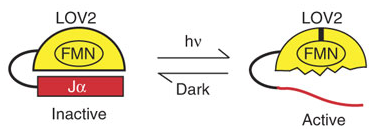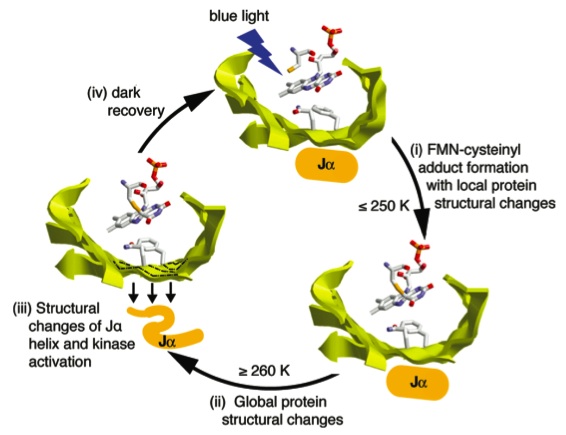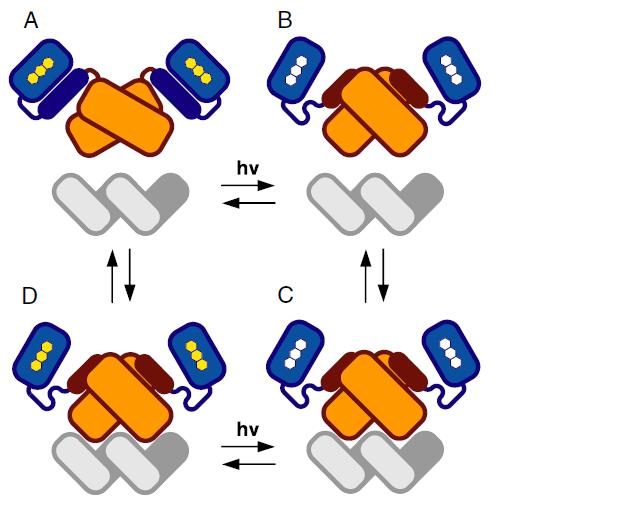Team:EPF-Lausanne/LOVTAP
From 2009.igem.org
| Line 43: | Line 43: | ||
We will also try to improve the LovTAP binding on DNA : a major problem is that the conformational change of LOVTAP is weak and the protection assay results show a small difference of LOVTAP binding on DNA between dark state and light state. We will use modeling to determine which nucleotide we could mutate in order to improve the stability of this binding state. | We will also try to improve the LovTAP binding on DNA : a major problem is that the conformational change of LOVTAP is weak and the protection assay results show a small difference of LOVTAP binding on DNA between dark state and light state. We will use modeling to determine which nucleotide we could mutate in order to improve the stability of this binding state. | ||
<br><br> | <br><br> | ||
| + | |||
| + | <html> | ||
| + | <p align="center" class="style1"><a href="#top"><img src="https://static.igem.org/mediawiki/2009/thumb/0/06/Up_arrow.png/50px-Up_arrow.png" alt="Back to top" border="0"></a><br></p> | ||
| + | </html> | ||
| + | <br> | ||
| + | |||
</div><div CLASS="epfl09bouchon"></div> | </div><div CLASS="epfl09bouchon"></div> | ||
Revision as of 08:47, 11 October 2009
Contents |
Brief overview
For organisms to thrive in a changing light environment, they sense and respond to light: the sensory information allows them to move in response to that stimulus. These responses are mediated by phototropins, which are photosensory proteins consisting of a serine-threonine kinase domain and a pair of nonidentical Light, Oxygen, or Voltage (LOV) sensitive domains which contain the noncovalently bound chromophore flavin mononucleotide (FMN).
In the article of Strickland et al., an allosteric switch was created by joining two domains, as expained below. The resulting protein has a domain-domain overlap with a shared helix, this shared helix acting as a rigid lever arm. The disruption of the helical contacts causes a shift in the conformation. Thus, photoexcitation would change the conformation of the protein, and that will change the stability of the helix-domain contacts. This will change the affinity of the shared helix for the two domains, and a signal could be then propagated.
The system is called LovTAP system. The light-sensitive input module is the LOV2 domain of Avena sativa phototropin 1 (AsLOV2). Absorption of a photon by AsLOV2 triggers the formation of a covalent adduct between FMN (the flavin mononucleotide) cofactor and a conserved cysteine residue. This formation leads to the displacement and unfolding of an helix in the LOV domain, which is likely to mediate a signal propagation. LOV domains absorb light through a flavin cofactor, photochemically form a covalent bond between the chromophore and a cysteine residue in the protein, and proceed to mediate activation of an attached kinase domain.
The output module was the bacterial transcription factor trp repressor (TrpR). TrpR can bind its operator DNA as a homodimer.
By ligating AsLOV2 to TrpR, they were able to construct an allosteric switch called LovTAP : LOV- and tryptophan-activated protein. This protein protects DNA from digestion when illuminated.

LovTAP can thus be found in two states : dark-state and light-state. The ground state is referred to as the ‘‘dark’’ state, and its photoactivated state as the ‘‘light’’ state. The TrpR domain associates with the shared helix (shared from AsLOV2 and TrpR).
during the photocycle. Taken from the article of Koyama and al. (17)
- In the dark state (A in the image below), a few residues of the shared helix presumably dissociate from the TrpR domain and dock against the LOV domain. The steric overlap is then relieved, which decreases the TrpR domain's DNA-binding affinity (when the shared helix contacts the LOV domain, the TrpR domain is in an inactive conformation).
- In the light state, the residues reassociate with the TrpR domains (because the photoexcitation disrupts contacts between the shared helix and the LOV domain), which restores DNA-binding affinity and the system is in the active form (B). LovTAP can then bind DNA. But this system is not stable, and the LOV domains returns to the dark state (C), which triggers the dissociation of LovTAP from the DNA (D).
In our project, the idea is to implement such a system in E. coli, using synthetic biology and then caracterise it in vivo (in the article they have only done the caracterisation in vitro).
First of all, we want to clone the LovTAP gene into an IPTG inductible BioBrick using a LacI promoter from the registry as well as a RBS and a terminator. Following this, we will clone a readout that would express RFP upon ligation of the LovTAP (after illumination) to its promoter sequence (the trp promoter). As we want to have RFP expression upon illumination (and thus binding of the LovTAP), we will need to create an inverter.
We will also try to improve the LovTAP binding on DNA : a major problem is that the conformational change of LOVTAP is weak and the protection assay results show a small difference of LOVTAP binding on DNA between dark state and light state. We will use modeling to determine which nucleotide we could mutate in order to improve the stability of this binding state.
 "
"



